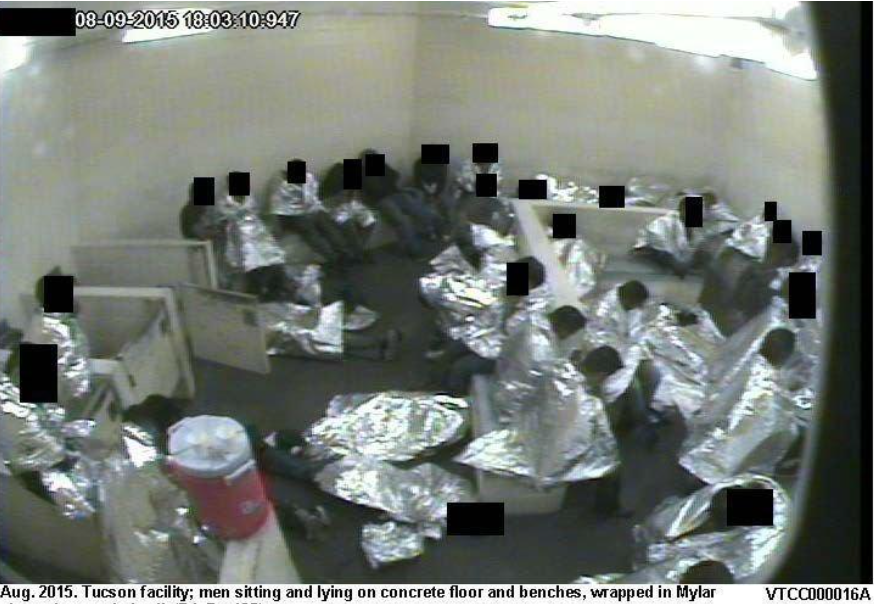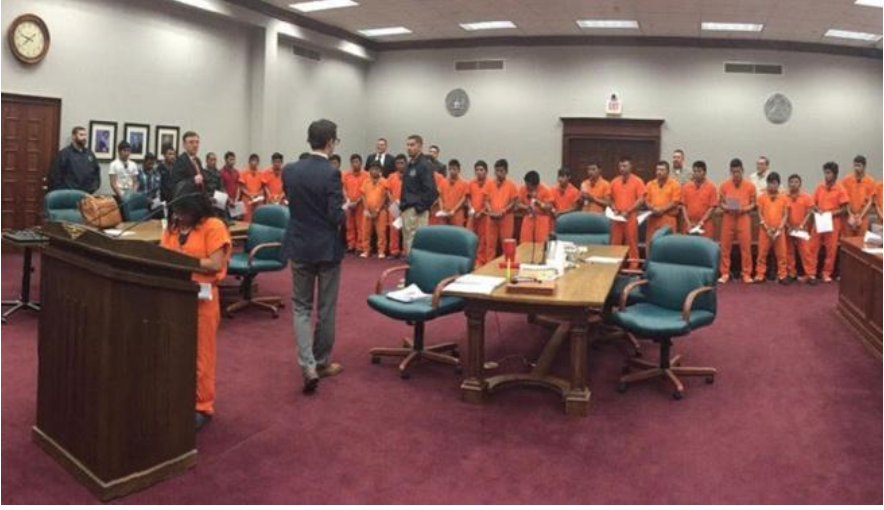What Happens After Crossing the Darien Gap and Making It to the U.S.
For many, the long journey through the Darien Gap, Central America, and Mexico, with all its dangers and costs, could end up back in Maiquetía, only a couple of years later. Henriquez explains the bureaucratic Darien that migrants face when they get to the US


Photo: IOM
An increasing number of forced migrants are putting their lives at risk by cutting across seven or more international borders and finally crossing a river or a desert north of Mexico. Led by unscrupulous smugglers and threatened by local armed groups, thousands cross the infamously dangerous Darien Gap, searching for safety and opportunities, with a clear goal: reaching the U.S. Once there, Customs and Border Protection (CBP) agents detain the migrants and hand them over to Immigration and Customs Enforcement (ICE) for further processing.
But what happens then? The end of a perilous passage doesn’t mean that they all get to stay and live the American dream. A new journey begins, one that involves a complex labyrinth of federal agencies, courts, filings, legal evidence, and, sometimes, long detentions.
The overwhelming majority of migrants crossing the border without inspection apply for asylum. Getting an asylum application approved depends on many factors, and one of the most significant is who does the evaluation. There are a few immigration judges with an asylum approval rate north of 62%—if you must, you would like to be in front of one of those—but there are others with 97% denial rates, or worse. These vast differences show that the exact same set of facts could yield a very different result, depending on the judge that hears it.
Different Buckets for Different Migrants
Before migrants can get to a judge to evaluate their asylum petition, many things can happen. We must understand that there are countless scenarios and not every person follows the same path, but most cases tend to follow certain patterns. The border is heavily guarded, so it is highly unlikely that migrants will evade detection and make it unnoticed to Miami, New York, or wherever they might have friends or family to help them settle, if they have any. Coyotes mostly instruct migrants to just hand themselves in to the authorities, and that is what generally happens. Some people try to evade being caught, mostly through the Arizona desert, and that extends the dangers of the long journey. Nature can be fierce, many die trying. But, again, most don’t even try.
When an immigration agent detains someone that just crossed the border, they assign them to different buckets: unaccompanied minors, families with minors, families without minors, and single adults.
Then, they check the fingerprints and run face-recognition software on every person over 14 years old to look at their immigration history or if there is an entry about them on the criminal background databases. Unaccompanied minors are assigned to a specific agency that handles their accommodations until an adult can pick them up, keeping them in shelters that resemble more an orphanage than a jail. Families with minors tend to be processed very quickly, being released around 48 hours after detention. Adults without children could face very different paths, from being released as fast as mothers with infants, to being detained indefinitely. Upon release, they are all still in the system and likely facing “removal proceedings,” that is, a process that could end in deportation.
ICE Detention: A Lot Like Jail
The detention process of adults is complicated and largely arbitrary. Two adults arriving at the same time but at different points of the border could be dealt with very differently, despite neither representing a security threat for past criminal behavior. While CBP and ICE figure out their next step, they are kept in small holding cells where the air conditioning is notoriously frigid: the infamous border ‘hieleras,’ or iceboxes, where people wait for about 48 hours. Migrants are handed aluminum blankets and the room temperature serves as an anesthetic; everyone is just quietly trying to endure the cold. From there, detainees are sent to ICE detention centers, the majority of which are between Texas, Arizona, Louisiana, and Mississippi.
Being detained by ICE is akin to being in jail. People are handcuffed for transportation, medical treatment is grim, and they are forced to wear orange or gray uniforms and share cells with unknown migrants. Rather minor incidents of misbehavior could yield harsh punishments like solitary confinement for days, or even changing their security classification and getting transferred to the dangerous detainee section, changing to a red uniform and sharing a cell with convicted drug dealers or murderers. Again, any adult crossing the border, without even a scintilla of evidence that they could represent a risk to the U.S., could end up detained, just for crossing the border. In 2022, it’s mere luck whether migrants are released after a couple of days or remain behind bars for a couple of months. Under the previous U.S. administration, longer periods of detention for a much larger share of migrants arriving through the border were the rule. The number of detainees and the length of time kept behind bars have been significantly reduced, but detention still happens.
To be released from custody, people must get ICE to agree to a bond or request a “custody determination hearing” before a judge. Doing this without a lawyer is like conducting surgery on yourself: not impossible, but probably not a great idea. Bonds range from 2,000 to 20,000 dollars, with the majority hovering around 10,000 dollars. There are companies that post bails for a profit, charging very high interest rates on loans. People can be released from detention and 10,000 dollars in debt, plus interests, before their asylum claim is even filed.
The Process After Detention
Once released—either after two days or after two months, for minors and adults alike—the U.S. still hasn’t decided on the underlying asylum claim that may determine if the person can legally stay. ICE officers hand former detainees a “Notice to Appear,” charging them with being removable and ordering them to appear before an immigration judge to defend themselves. That’s when they will be able to present an asylum application, before the immigration court with jurisdiction over their new domicile. Some cases fall through the cracks and migrants must file their asylum cases with an administrative agency: U.S. Customs and Immigration Services (USCIS). Although this must be done before the one-year mark, it’s not all bad, as it gives applicants two bites of the apple: they can try their asylum claim with an asylum officer before even going to court. If approved by USCIS, their case is happily resolved without ever seeing a judge. If denied by USCIS, they will end up where they should have started: in immigration court.
Minors who have been abandoned, neglected, or abused by at least one parent have an interesting alternative to asylum, known as Special Immigrant Juvenile Status (SIJ). It’s a two-step process, the first of which is ruled by state law, so the domicile of the minor may determine if they are granted or not. Some states are much friendlier than others, and even within states, approval rates by counties can vary. If a state judge rules that the minor has been abandoned, neglected, or abused, and that it’s not in their best interest to return to Venezuela, the minor can request a green card from USCIS. The caveat is that they will never be able to petition for their parents, even the parent who was always next to the child.
For those stuck with an asylum application, they must persuade the authorities that they have an individualized risk of returning to Venezuela because of their political opinion, membership in a particular social group, race, religion, or nationality.
The fact that the U.S. recognizes the humanitarian crisis and mass human rights violations in Venezuela isn’t even close to being enough. Just being a member of an opposition political party, having attended marches where there was repression, or being the victim of violent crimes at the hands of unknown assailants, tends to fall short too. Asylum is approved when the judge believes that the migrant has a clear risk of being individually targeted for persecution by the Venezuelan regime, or a group that the regime is unwilling or unable to control, but that excludes regular criminality.
A Process That Could End in Deportation
Processes can last as little as eight months, and as long as six years or more, depending on multiple factors. If a judge denies asylum, he or she will issue an order of removal. Appeals are possible, but they don’t tend to buy much time and can be very costly. With no direct flights between the U.S. and Venezuela, mass deportations are impracticable. Nowadays, deportations of Venezuelans are rare and happen to a few, but they do happen.
There are currently thousands of Venezuelans who have been issued orders of removal, yet remain in the U.S., knowing that any day they could be forced to leave. The Temporary Protected Status (TPS) that was granted on March 8th, 2021, is only valid for those that had arrived before that decision. The tens of thousands of Venezuelans that crossed the border after that are not protected by the TPS. They could—if they’re not granted asylum, SIJ, or another form of immigration relief—be deported back to Venezuela.
For many, the long journey through the Darien Gap, Central America and Mexico, with all its dangers and costs, could end up back in Maiquetía, only a couple of years later. Others will be able to prove their asylum claims, build a life in the U.S., with its struggles and successes, and find a path to U.S. citizenship.
Caracas Chronicles is 100% reader-supported.
We’ve been able to hang on for 22 years in one of the craziest media landscapes in the world. We’ve seen different media outlets in Venezuela (and abroad) closing shop, something we’re looking to avoid at all costs. Your collaboration goes a long way in helping us weather the storm.
Donate






